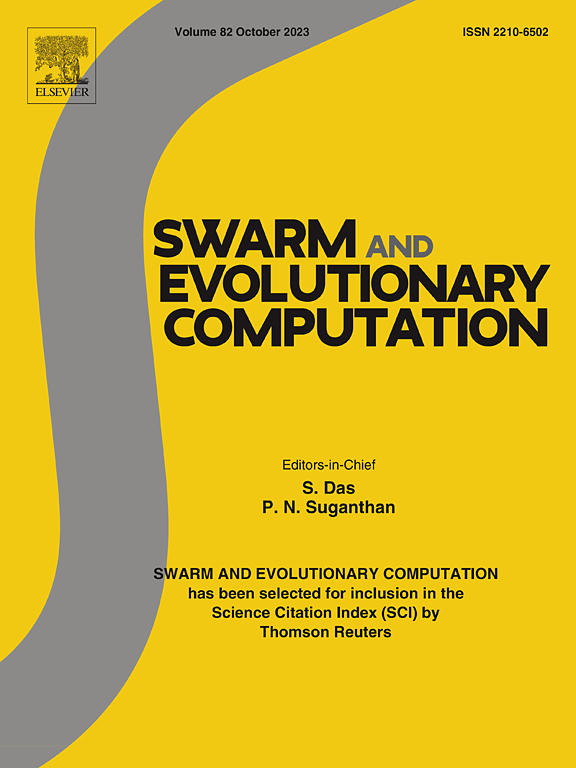Incremental learning-enhanced ensemble surrogate-assisted evolutionary algorithm for lifelong berth allocation and quay crane assignment problems
IF 8.5
1区 计算机科学
Q1 COMPUTER SCIENCE, ARTIFICIAL INTELLIGENCE
引用次数: 0
Abstract
The berth allocation and quay crane assignment problem (BACAP) is a critical challenge in maritime transport, especially in lifelong scenarios that are rarely addressed in the current literature but essential for practical applications. The Lifelong BACAP (LBACAP) presents new challenges, such as the uncertain arrival of vessels, limited resources, and inter-dependencies between vessels. To address these challenges, we propose an incremental learning-enhanced ensemble surrogate-assisted evolutionary algorithm, named IL-ESAEA, with three core designs. (1) The adaptive rolling-horizon strategy divides the LBACAP into consecutive time windows, each corresponding to an interconnected sub-LBACAP. (2) The ensemble surrogate-assisted evolutionary algorithm (ESAEA) approximates the computationally intensive and intricately designed decoding method for optimization, reducing computational costs while maintaining robust search capabilities for solving various BACAPs. (3) The incremental learning mechanism identifies connections between sub-LBACAPs in successive time windows, utilizing historical decisions to guide the optimization effectively. Experimental results demonstrate that IL-ESAEA consistently outperforms state-of-the-art algorithms and provides superior solutions with increased computational efficiency over time. This highlights the strong competitive edge of IL-ESAEA in solving LBACAPs.
基于增量学习增强的集成代理辅助进化算法的终身泊位分配和码头起重机分配问题
泊位分配和码头起重机分配问题(BACAP)是海上运输中的一个关键挑战,特别是在目前文献中很少涉及但对实际应用至关重要的终身场景中。终身BACAP (LBACAP)提出了新的挑战,如船舶到达的不确定性、有限的资源以及船舶之间的相互依赖性。为了解决这些挑战,我们提出了一种增量学习增强集成代理辅助进化算法,名为IL-ESAEA,具有三个核心设计。(1)自适应滚动水平策略将LBACAP划分为连续的时间窗,每个时间窗对应一个相互关联的子LBACAP。(2)集成代理辅助进化算法(ESAEA)近似于计算密集型和复杂设计的解码方法进行优化,降低了计算成本,同时保持了解决各种bacap的强大搜索能力。(3)增量学习机制在连续的时间窗口中识别子lbacap之间的联系,利用历史决策有效地指导优化。实验结果表明,IL-ESAEA始终优于最先进的算法,并随着时间的推移提供了更高的计算效率。这凸显了IL-ESAEA在解决lbacap方面的强大竞争优势。
本文章由计算机程序翻译,如有差异,请以英文原文为准。
求助全文
约1分钟内获得全文
求助全文
来源期刊

Swarm and Evolutionary Computation
COMPUTER SCIENCE, ARTIFICIAL INTELLIGENCEC-COMPUTER SCIENCE, THEORY & METHODS
CiteScore
16.00
自引率
12.00%
发文量
169
期刊介绍:
Swarm and Evolutionary Computation is a pioneering peer-reviewed journal focused on the latest research and advancements in nature-inspired intelligent computation using swarm and evolutionary algorithms. It covers theoretical, experimental, and practical aspects of these paradigms and their hybrids, promoting interdisciplinary research. The journal prioritizes the publication of high-quality, original articles that push the boundaries of evolutionary computation and swarm intelligence. Additionally, it welcomes survey papers on current topics and novel applications. Topics of interest include but are not limited to: Genetic Algorithms, and Genetic Programming, Evolution Strategies, and Evolutionary Programming, Differential Evolution, Artificial Immune Systems, Particle Swarms, Ant Colony, Bacterial Foraging, Artificial Bees, Fireflies Algorithm, Harmony Search, Artificial Life, Digital Organisms, Estimation of Distribution Algorithms, Stochastic Diffusion Search, Quantum Computing, Nano Computing, Membrane Computing, Human-centric Computing, Hybridization of Algorithms, Memetic Computing, Autonomic Computing, Self-organizing systems, Combinatorial, Discrete, Binary, Constrained, Multi-objective, Multi-modal, Dynamic, and Large-scale Optimization.
 求助内容:
求助内容: 应助结果提醒方式:
应助结果提醒方式:


